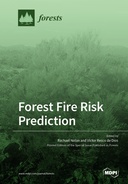Explore

Forest Fire Risk Prediction
0 Ungluers have
Faved this Work
Login to Fave
Globally, fire regimes are being altered by changing climatic conditions and land use changes. This has the potential to drive species extinctions and cause ecosystem state changes, with a range of consequences for ecosystem services. Accurate prediction of the risk of forest fires over short timescales (weeks or months) is required for land managers to target suppression resources in order to protect people, property, and infrastructure, as well as fire-sensitive ecosystems. Over longer timescales, prediction of changes in forest fire regimes is required to model the effect of wildfires on the terrestrial carbon cycle and subsequent feedbacks into the climate system.This was the motivation to publish this book, which is focused on quantifying and modelling the risk factors of forest fires. More specifically, the chapters in this book address four topics: (i) the use of fire danger metrics and other approaches to understand variation in wildfire activity; (ii) understanding changes in the flammability of live fuel; (iii) modeling dead fuel moisture content; and (iv) estimations of emission factors.The book will be of broad relevance to scientists and managers working with fire in different forest ecosystems globally.
This book is included in DOAB.
Why read this book? Have your say.
You must be logged in to comment.
Rights Information
Are you the author or publisher of this work? If so, you can claim it as yours by registering as an Unglue.it rights holder.Downloads
This work has been downloaded 182 times via unglue.it ebook links.
- 182 - pdf (CC BY) at Unglue.it.
Keywords
- acid rain
- Aerosol
- alien pathogen
- allochthonous species
- Biology, Life Sciences
- biomass burning
- canopy bulk density
- China
- Climate Change
- critical LFMC threshold
- crown fire
- Cupressus sempervirens
- direct estimation
- Disease
- drought
- drying tests
- Economics, finance, business & management
- epicormic resprouter
- Eucalyptus
- fire behavior
- fire danger
- fire danger rating
- fire management
- fire modeling
- Fire regime
- fire risk
- fire season
- fire severity
- fire size
- fire weather
- fire weather patterns
- flammability
- flammability feedbacks
- foliar moisture content
- forest fire
- forest fire driving factors
- forest fire management
- forest fire occurrence
- forest/grassland fire
- Forestry & related industries
- fuel moisture
- fuel moisture content
- fuels
- FWI system
- humidity diffusion coefficients
- Industry & industrial studies
- introduced fungus
- leaf water potential
- Machine learning
- mass loss calorimeter
- Mathematics & science
- meteorological factor regression
- MNI
- modeling
- moisture content
- n/a
- occurrence of forest fire
- plant traits
- PM2.5
- Portugal
- prediction accuracy
- prescribed burning
- Primary industries
- radiative transfer model
- random forest
- RCP
- Reference, information & interdisciplinary subjects
- Remote sensing
- Research & information: general
- Seiridium cardinale
- senescence
- southwest China
- SSR
- temperate forest
- time lag
- variable importance
- vulnerability to wildfires
- wildfire
Links
DOI: 10.3390/books978-3-0365-1473-4Editions

